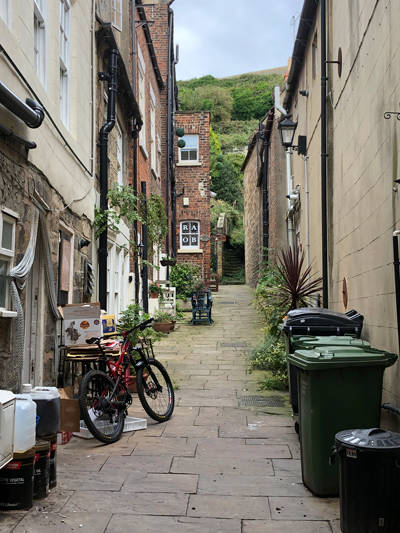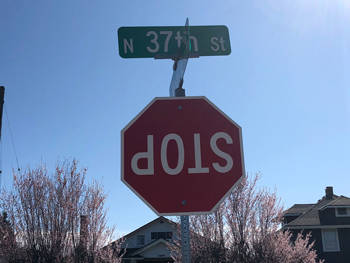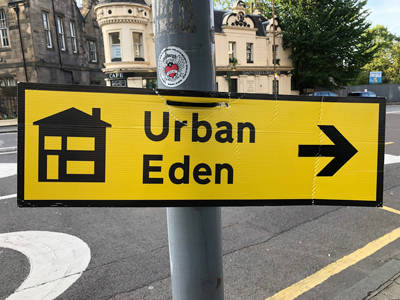By Morf Morford
Tacoma Daily Index
There’s a world of difference between American cities and traditional cities of Europe or Asia.
By traditional cities, I mean those cities (or at least parts of them) built by and for people.
It’s an odd thing to think about, but virtually every American city, and essentially every neighborhood and aspect of our cities was designed and built not for (and by) people, but by and for the advantage of machines.
Our streets, by historic standards, are huge and deliberately intended for the use and well-being of machines.
Vast tracts of our landscape, dedicated to machines, are clearly territory unsafe and unwelcoming to human beings (if not all living beings).
Our streets, highways and parking lots dominate our landscape, our schedules and our budgets.
From the air for example, parking lots and streets take up a huge percentage of typical urban real estate.
Our streets are wide, designed for speed and access, including turn-around areas for large vehicles like garbage trucks or emergency vehicles.
Traditional streets (those built before the dominance, if not conquest of automobiles and other vehicles) were narrow, designed for maximum access of individuals and perhaps, a cart or pack animal of some sort.
A thousand years might separate one street or neighborhood from another in Europe or Asia, even though they may be only a few feet apart.
In the USA, a century or two might separate streets or neighborhoods, and those few neighborhoods or alleys non-conforming to the needs of cars and other vehicles still exist largely by neglect or accident.
Some American cities have what are called “old towns.” These are the original city centers of the first European settlements.
These, largely accidently preserved, areas have a distinctly different “feel” from the rest of the prevailing areas: the streets (or alleys) are far narrower, the buildings far closer (possibly even attached) in violation of current fire and access codes.
In other words, designed and intended for human use before the advent of machines, these areas, again, by accidental design, preclude them.
In times of design or reconstruction, as in following natural catastrophes like earthquakes or hurricanes, these issues of design come to dominate conversations and budgets.
Who, or what, are our cities designed for?
If you’ve ever had a car problem, like a flat tire or an in-vehicle issue as in a medical problem, along a freeway, you suddenly realize how unwelcome you are in a landscape where vehicles whizz by (as they are supposed to) and how difficult – and dangerous – it is for anyone, even emergency vehicles, to stop and assist.
As our cities and highways respond to hurricanes, flooding and rising sea levels, rebuilding and re-design must take these new demands and features into consideration.
The original American urban design strategy is very strange when you think about it; how can vehicles enter and exit urban centers as quickly and unimpeded as possible.
That’s it.
It’s as if people didn’t exist, or didn’t matter and that cities had no appeal, or even existence of interest to anyone.
Passage through is the primary, if not exclusive, design assumption for most American cities.
There are other, deeper, more enduring and more historic uses for streets.
Any tool, any item that can be used, is either a very specific tool, made for one purpose or is an all or at least multi-purpose tool.
Expressways are a single-use creation – again designed for speed and limited access.
Too many urban neighborhoods are sterile and lifeless. Even malls, with their vast parking areas, from the outside, look empty and abandoned.
Where are places where any of us can go or gather without the expectation of spending? Where are our neutral public spaces?
Maybe right in front of us.
Streets, especially neighborhood streets are designed for a multiplicity of uses. They unite and divide neighborhoods, they connect, block, they provide access and even identity to the residents or anyone else that uses them.
Local streets provide parking, access and even space for celebrations and gatherings.
Some streets are closed off for festivals or farmers markets.
Odd weekends
I use the word odd in both senses of the word; the odd-numbered weeks of the month (first and third) and odd as in unpredictable and unexpected.
Farmers markets (for many justifiable reasons) are tightly controlled in terms of price, product and credentials or backgrounds of those offering their wares there.
I want to emphasize that there are good, solid reasons for having fairly strict guidelines and rules for farmers markets – I’d just like to see a little more serendipity factored in.
My ideal street market would have a little section where the standard rules don’t apply.
Like a street market of a millennia ago, this could be where anyone could sell or barter (almost) anything.
Someone moving could sell their furniture, a family could sell their no longer needed baby clothes, craftspeople could sell their wares, kids could sell their art projects for spare money.
Collectors could sell books, records or excess craft materials. This would be close to the original idea of a flea market where anything, from home-crafted foods to antiques or old tools could be found. This is the territory where discoveries are made and art is created.
Long out-of-print books, long out-of-fashion clothing including strange hats or even military gear could be found here.
Not the usual mix of a farmer’s market products for sure, but far more interesting than the usual seasonal fruit or vegetables.
I could certainly fill my own fold-up table of eclectic tools, home design magazines from the 1980s and more DVDs and books than I’d like to acknowledge ever buying and vastly more from my basement and attic spaces.
Someone, some collector or even some museum or historical society wants that stuff before it hits the garbage pile.
I’d also like to see a free section. This could be a section where any of us could drop off (or pick up) anything with some use left in it from furniture to leftover building materials. Some agency, like Goodwill or St. Vincent’s could be contracted to pick up any unclaimed material.
As our economy declines, foreclosures increase and food insecurity emerges in unexpected places, non-profits could work together with, at minimum, referrals where those in need could find food or other resources.
When it comes to food, or almost anything really, I’d like to see a joint project between the FB Buy Nothing group and Food is Free (https://foodisfree253.com/) with a center for no-obligation, no-criteria free stuff.
Yes, I know it is a crazy idea, but our situation this season is like no other, where expectations, assumptions and basic needs collide, mangle and mix and look like nothing any of us have seen before.
Maybe, in the context of 2020, and whatever follows it, an Odd Weekend festival/flea market is not such a wacky idea after all.
Our streets, our economy and our daily routines look nothing like they did a year ago. What any of it will look like a year from now is anyone’s guess.
My bias is that our cities and neighborhoods are suitable, welcoming and even appealing – and not only for us, but for those a generation or two, or ten from now.
We can get some guidelines from films like The Human Scale (https://www.imdb.com/title/tt2414454/?ref_=nm_knf_i3) but we can always pay more attention to what appeals to, or works for us and what we would prefer to have around us and, more than we might imagine, defines us.







